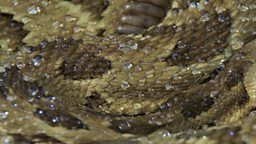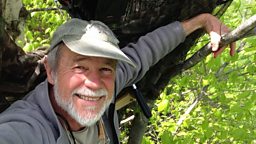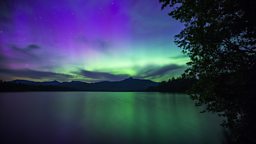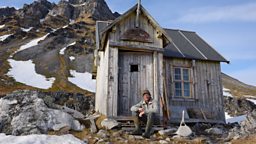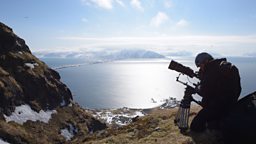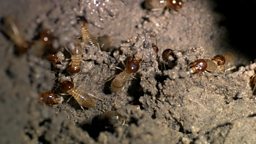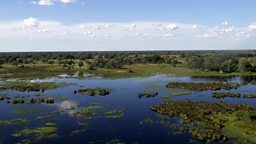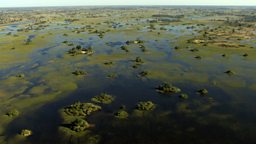Filming the changing seasons
Paul Williams, producer
One of the key challenges of this series was to show just how the forest changes, from the close up details of an individual leaf, to the transformations that can be seen from space.
Seasonal lapsed time shots
The first requirement was spectacular forest locations that could be visited several times, through the year, to create seasonal time-lapse shots.
My first trip, in March 2015, was to the White Mountains, New Hampshire, the forest was still in the grip of winter. Driving along the Kancamagus Highway, I was excited to discover a young sugar maple tree, growing the classic shape of a heart. The tree’s barren branches even looked like the arteries and veins running through a human heart. To me it was the perfect symbol of just how the trees are the lifeblood of this corner of America. Together, the states of New England are 80% covered in trees, more than any other state in the US and its autumnal display draws millions of people every year. As bare as it was, I was sure that in the autumn the heart tree would turn from vivid greed to bright red and orange - and 8 months later it did!
I visited the tree 5 times through the year in order to take a series of time-lapses that show it in it’s different seasonal foliage. One night I slept by the tree in freezing conditions as my cameras captured the stars moving overhead, a shot which took 5 hours to complete. I would often have 3 time-lapse cameras and a video camera running at once, to capture the tree in different ways and from different perspectives.
Through the year I fell in love with this maple tree. The film opens with the bare heart tree in March and revisits the tree as it transforms at various stages during the year.
Fixed cameras
But of course, one tree turning doesn’t make an autumn. Working with Harvard Forest in Massachusetts we installed 7 fixed cameras to take images through the day, every day, all year round. These cameras were added to their wider camera network, , which captures images of the forest for scientific research.
Macro leaf timelapse
At the other end of the scale it was our mission to reveal the minutest of details. So to film a single leaf turning, we enlisted plant time-lapse expert, Tim Shepherd. Thanks to the effects of wind and extreme changes of light, it’s impossible to film something like this well, out in the wild so in Tim’s environmentally controlled studio he grew maple and oak saplings and used time-lapse techniques to film the different stages of the growth of their leaves, through the seasons. He filmed the details of buds as they grew in spring, and then the young leaves as they expanded into summer. The crescendo of his work for this film was to capture individual leaves as they changed from green to yellow, orange and red - each shot took several weeks to complete.
Timelapse from space
The transformation of New England from space was possible thanks to NASA’s satellites equipped with Modis remote sensing cameras capture daily high resolution images of this part of the United States. It was just a matter of going through their archive to find the exactly the right images, with the least cloud cover, and then crafting a sequence from the right images to create a presentable time-lapse from space. The results amazed us – it’s incredible that something as minuscule as the chemical changes the leaves of the trees can be seen so .
Historical lapsed time
A key part of the story of the New England forest is how it came to be such an amazing spectacle in the first place. Research revealed something that we really didn’t expect – not only was it down to a group of animals, but surprisingly it was down to our own species too – the British, to be precise. Once settlers arrived from Britain, some 400 years ago, the forests were almost completely felled, to create farmland and towns. But then in the mid 1800's many of these towns were abandoned, as people headed west, in search of better farmland – and gold! With everyone gone, the trees grew back again, but this new forest was very different. The wide open spaces were perfect for nurturing hardwoods, such as maples an oaks – the very trees that produce such a spectacle in the fall. To help tell this story, we discovered old black and white photographs of towns, in the White Mountains, that have long since disappeared. Working with local historians we were able to locate the exact spot at which those photographs had been taken, almost a century ago, and we lined up the shot to show just how much it has changed. This allowed us to create historical time transitions showing that where a town once stood a town, there now stands a maple forest.

The reds and oranges and golds set the New England forest ablaze
贵辞谤鈥卝耻蝉迟鈥卆鈥协别飞鈥厀别别办蝉鈥卐惫别谤测鈥厃别补谤鈥匩别飞鈥匛苍驳濒补苍诲鈥卛蝉鈥卆鈥厀辞苍诲别谤濒补苍诲鈥卭蹿鈥卌辞濒辞耻谤.






